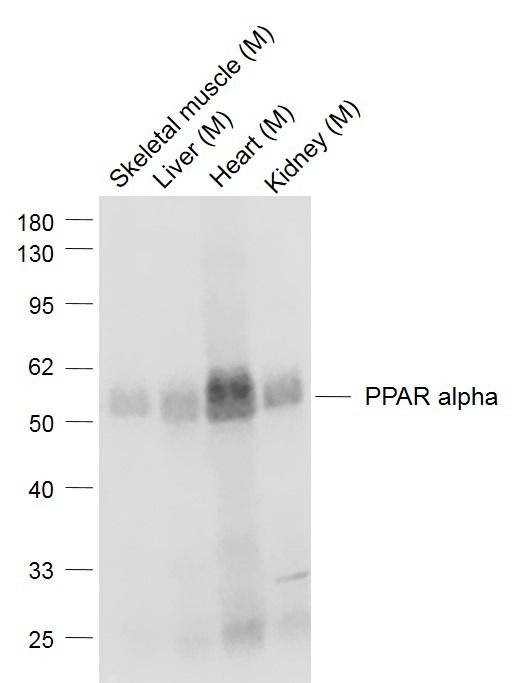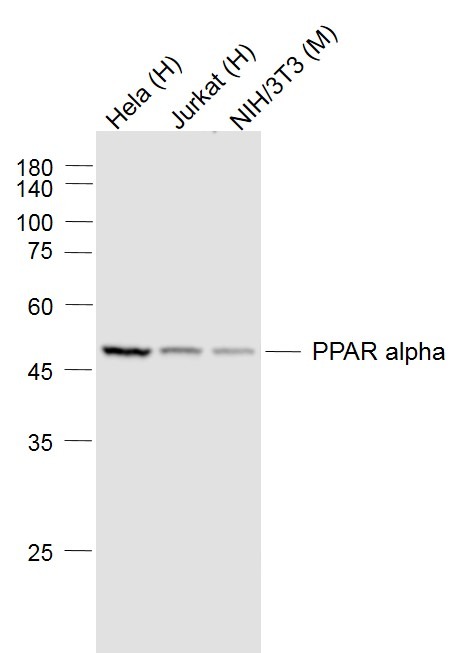Shopping Cart
Remove All Your shopping cart is currently empty
Your shopping cart is currently empty
Anti-PPAR alpha/PPARA Antibody (3P706) is a Mouse antibody targeting PPAR alpha/PPARA. Anti-PPAR alpha/PPARA Antibody (3P706) can be used in ICC/IF,IF,IHC-Fr,IHC-P,WB.
| Pack Size | Price | USA Warehouse | Global Warehouse | Quantity |
|---|---|---|---|---|
| 50 μL | $296 | 7-10 days | 7-10 days | |
| 100 μL | $488 | 7-10 days | 7-10 days |
| Description | Anti-PPAR alpha/PPARA Antibody (3P706) is a Mouse antibody targeting PPAR alpha/PPARA. Anti-PPAR alpha/PPARA Antibody (3P706) can be used in ICC/IF,IF,IHC-Fr,IHC-P,WB. |
| Synonyms | PPAR-α, PPARα, PPAR-alpha, PPARalpha, Ppar, peroxisome proliferator-activated receptor α, peroxisome proliferator-activated receptor alpha, Nr1c1, AW742785, 4933429D07Rik |
| Ig Type | IgG1 |
| Clone | 3P706 |
| Reactivity | Human,Mouse |
| Verified Activity | 1. Sample: Lane 1: Skeletal muscle (Mouse) Lysate at 40 μg Lane 2: Liver (Mouse) Lysate at 40 μg Lane 3: Heart (Mouse) Lysate at 40 μg Lane 4: Kidney (Mouse) Lysate at 40 μg Primary: Anti-PPAR alpha (TMAB-01563) at 1/1000 dilution Secondary: IRDye800CW Goat Anti-Mouse IgG at 1/20000 dilution Predicted band size: 51 kDa Observed band size: 51 kDa 2. Sample: Lane 1: Hela (Human) Cell Lysate at 30 μg Lane 2: Jurkat (Human) Cell Lysate at 30 μg Lane 3: NIH/3T3 (Mouse) Cell Lysate at 30 μg Primary: Anti-PPAR alpha (TMAB-01563) at 1/1000 dilution Secondary: IRDye800CW Goat Anti-Mouse IgG at 1/20000 dilution Predicted band size: 52 kDa Observed band size: 52 kDa   |
| Application | |
| Recommended Dose | WB: 1:500-1000; IHC-P: 1:100-500; IHC-Fr: 1:400-800; ICC/IF: 1:20-100; IF: 1:20-100 |
| Antibody Type | Monoclonal |
| Host Species | Mouse |
| Subcellular Localization | Nucleus. |
| Tissue Specificity | Skeletal muscle, liver, heart and kidney. |
| Construction | Hybridoma Monoclonal Antibody |
| Purification | Protein G purified |
| Appearance | Liquid |
| Formulation | 0.01M TBS (pH7.4) with 1% BSA, 0.02% Proclin300 and 50% Glycerol. |
| Concentration | 1 mg/mL |
| Research Background | Peroxisome proliferators are nongenotoxic carcinogens which are purported to exert their effect on cells through their interaction with members of the nuclear hormone receptor family, termed Peroxisome Proliferator Activated Receptors (PPARs). Nuclear hormone receptors are ligand dependent intracellular proteins that stimulate transcription of specific genes by binding to specific DNA sequences following activation by the appropriate ligand. Studies indicate that PPARs are activated by peroxisome proliferators such as clofibric acid, nafenopin, and WY-14,643, as well as by some fatty acids. It has also been shown that PPARs can induce transcription of acyl coenzyme A oxidase and cytochrome P450 A6 (CYP450 A6) through interaction with specific response elements. PPAR alpha is activated by free fatty acids including linoleic, arachidonic, and oleic acids. Induction of peroxisomes by this mechanism leads to a reduction in blood triglyceride levels. PPAR alpha is expressed mainly in skeletal muscle, heart, liver, and kidney and is thought to regulate many genes involved in the beta-oxidation of fatty acids. Activation of rat liver PPAR alpha has been shown to suppress hepatocyte apoptosis. PPAR alpha, like several other nuclear hormone receptors, heterodimerizes with retinoic X receptor (RXR) alpha to form a transcriptionally competent complex. |
| Immunogen | KLH conjugated synthetic peptide: human PPAR alpha |
| Antigen Species | Human |
| Gene Name | Ppara |
| Gene ID | |
| Protein Name | Peroxisome proliferator-activated receptor alpha |
| Uniprot ID | |
| Biology Area | Metabolism of lipids and lipoproteins,Response to hypoxia,Nuclear hormone receptors,Metabolism,Zinc Finger,Fatty acids,Lipid metabolism,Mitochondrial transcription,Hypoxia,Mitochondrial Biogenesis,Fatty acid oxidation,Obesity |
| Function | Ligand-activated transcription factor. Key regulator of lipid metabolism. Activated by the endogenous ligand 1-palmitoyl-2-oleoyl-sn-glycerol-3-phosphocholine (16:0/18:1-GPC). Activated by oleylethanolamide, a naturally occurring lipid that regulates satiety (By similarity). Receptor for peroxisome proliferators such as hypolipidemic drugs and fatty acids. Regulates the peroxisomal beta-oxidation pathway of fatty acids. Functions as transcription activator for the ACOX1 and P450 genes. Transactivation activity requires heterodimerization with RXRA and is antagonized by NR2C2. |
| Molecular Weight | Theoretical: 51 kDa. |
| Stability & Storage | Store at -20°C or -80°C for 12 months. Avoid repeated freeze-thaw cycles. |
| Transport | Shipping with blue ice. |
| Size | Quantity | Unit Price | Amount | Operation |
|---|

Copyright © 2015-2025 TargetMol Chemicals Inc. All Rights Reserved.